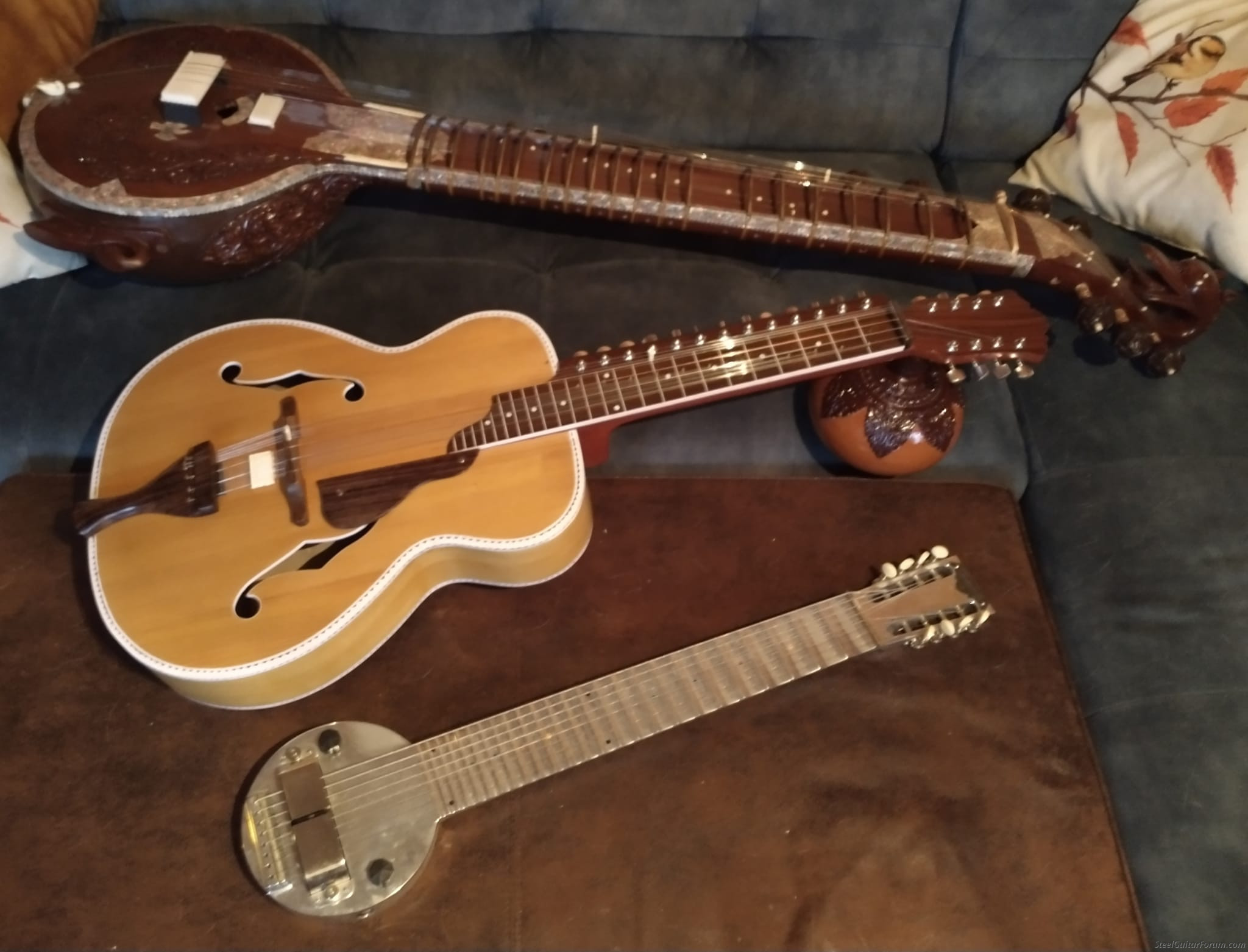Nic Neufeld
From:
Kansas City, Missouri
|
 Posted 20 Dec 2022 6:40 am
Posted 20 Dec 2022 6:40 am |
|
A tiny bit of background about me...about 12 years ago I wanted to learn a new instrument, and two very different possibilities stuck out to me...Indian classical sitar, or Hawaiian steel guitar. I was at least not foolish enough to think I could swing both at the same time, so I had to choose, and I picked sitar. I studied for about 7 years with weekly remote lessons (and occasional visits, he lived 4 hours away in St Louis) under Ustad Imrat Khan, at that time the eldest of the Imdadkhani gharana, and younger brother of the famous sitarist Ust Vilayat Khan. He was probably slightly more well known as an exponent of the surbahar (bass or baritone voiced sitar, essentially).
Anyway, while my skills (and callouses) have atrophied since that time, maybe 5 years back I decided to circle back to steel guitar and learn that properly as well. (and, well, here I am). Also blessed to learn from a great teacher, Alan Akaka.
So with sitar/surbahar on one hand, and Hawaiian steel guitar on the other, I suppose bridging the two was inevitable:

This is the Mohan veena style, in the style of Vishwa Mohan Bhatt (other similar "Indian slide guitars" include Debashish Bhattacharya's various instruments including the chaturangui, and the Hansa veena of the late Barun Kumar Pal...as well as the much more ancient vichitra veena which bears much less resemblance to the steel guitar).
The guitar is set up with a S-P-S main playing string set, in D sa. The chikari have a raised (very slightly, making it easier in fast play to strike only these) sa-sa octave pair, with the drone strings (to me, still basically chikari, coming from the Etawah style of sitar) tuned Pa, Ga, and Ni. The extra Ni drone is nice, and adds very sweet color in certain raags. The taraf are basically identical to sitar, with a jawari bridge and tuned to the notes of the raag played.
I sourced this from Lars Jacobsen of Rain City Music, from whom I bought my first sitar...you might pay a bit more than ordering direct from India might seem to imply, but you're not going to run the risk of getting a "firewood" instrument from an unscrupulous seller. He knows his stuff and the setup was excellent.
Funnily enough, while normally I'm a bullet bar guy and I never got the hang of the Shubb bar I bought for Dobro, I found that kind of bar works great for this instrument (lots of bar lifting and you never play two strings at once). Glad to have found a useful purpose for that thing, had been just sitting in a drawer!
_________________
Waikīkī, at night when the shadows are falling
I hear the rolling surf calling
Calling and calling to me |
|
Nic Neufeld
From:
Kansas City, Missouri
|
 Posted 20 Dec 2022 10:08 am
Posted 20 Dec 2022 10:08 am |
|
This article has some of the history...
https://www.premierguitar.com/artists/the-secret-world-of-hindustani-slide
It does say that Brij Bushan Kabra, who most people will credit as the initial of several pioneers of the Indian slide guitar (again not including the much more ancient veenas played with a ceramic egg...those would likely be tied more to the older styles of dhrupad and some southern Carnatic music), and he started with a Gibson Super 400 with additional chikari (the chimey drone strings) added. Since then though pretty much there are enough local guitar makers that it makes it a lot more efficient for them to be built by Indian makers (who are going to be much more familiar with Indian music concepts...ask a Western luthier to make a good jawari bridge for sympathetic strings...that's a skill that takes years to master!). Conchord was/is a major maker of the Mohan veenas, and I think Debashish's ones are mostly made by a maker called Tronad.
_________________
Waikīkī, at night when the shadows are falling
I hear the rolling surf calling
Calling and calling to me |
|
Tim Toberer
From:
Nebraska, USA
|
 Posted 21 Dec 2022 8:41 am
Posted 21 Dec 2022 8:41 am |
|
Here are some better pictures of the Super 400 and others. Lots off new ideas for instrument builders here. http://preparedguitar.blogspot.com/2015/09/debashish-bhattacharya-13-questions.html
This is quite a rabbit hole to go down! Indian music seems so alien and yet familiar. Personally speaking, it is hard to fathom (as a westerner) a music that has developed slowly over 1000's years. In a world that is in a state of hyper evolution, (or de-evolution it seems at times), these old traditions will remain as something we can always build upon. Music is like many things from architecture to social customs. It can be a little scary to venture out of the bubble, so most just happily stay in. Thanks for sharing this! |
|




